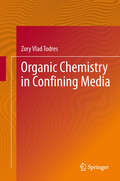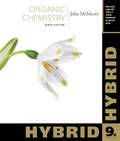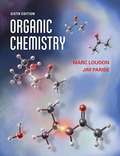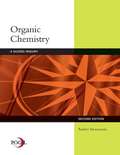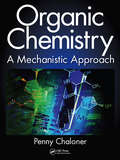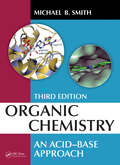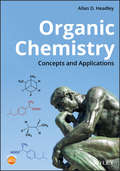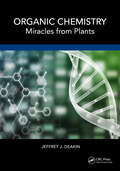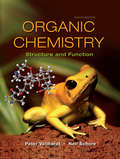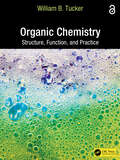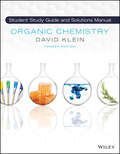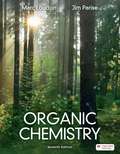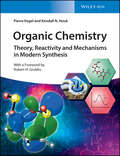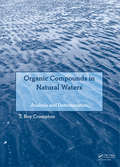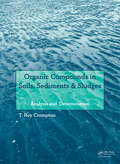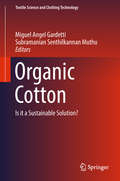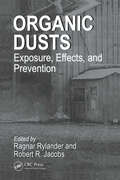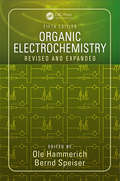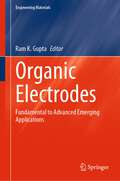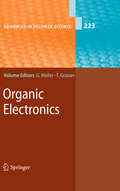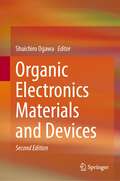- Table View
- List View
Organic Chemistry in Confining Media
by Zory Vlad TodresZory Vlad Todres' monograph offers a fresh insight into an important and developed area of organic chemistry. Calixarene, cyclodextrins, and cucurbiturils as host molecules are well known, but the corresponding new and demonstrative publications deserve new exposition. This book principally widens our consideration of organic reactivity in confining media. Topics discussed include: effects of micellization, porous effects, effects of solvent cages, complexation to organometallic compounds, hydrogen-bond or charge-transfer complexation, sorption effects, effects of solvents, and stereochemical changes upon confinement. Organic Chemistry in Confining Media is useful for experienced organic chemists working in academia or industry, as well as chemists working in fields contiguous to organic chemistry.
Organic Chemistry, Hybrid Ninth Edition
by John McmurryMaster organic chemistry with the help of this proven best-seller! John McMurry's ORGANIC CHEMISTRY is consistently praised as the most clearly written book available for the course.
Organic Chemistry, Sixth Edition
by Marc Loudon Jim PariseThis edition contains over 1,600 problems--many of them new and taken directly from the scientific literature. It provides students with more health examples drawn from modern medical practice, as well as many cutting-edge topics from modern synthetic organic chemistry.
Organic Chemistry, Volume One: Part I: Aliphatic Compounds Part II: Alicyclic Compounds (Dover Books on Chemistry #1)
by Frank C. WhitmoreA rich source of chemical facts, theories, and processes, this two-volume series treats the entire subject of organic chemistry. It has served for decades as a reference for chemists in industry and education as well as a classroom text for students with a year or more of experience in organic chemistry.Volume One provides thorough coverage of aliphatic compounds, devoting 500 pages to the physical properties and various methods of synthetic preparation of hydrocarbons, halides, alcohols, ethers, carbohydrates, proteins, ketones, amines, monobasic acids, and many other related compounds. The second part of this volume discusses alicyclic compounds, with reactions, isomers, and processes given for terpenes, cyclopropane derivatives, carotenoids, and the cholane series. Methods of synthetic preparation receive a critical analysis, and many biochemical compounds are described.
Organic Chemistry: 8th Edition
by Paula Yurkanis BruiceFor courses in Organic Chemistry (2-Semester) Paula Bruice’s presentation in Organic Chemistry, Eighth Edition provides mixed-science majors with the conceptual foundations, chemical logic, and problem-solving skills they need to reason their way to solutions for diverse problems in synthetic organic chemistry, biochemistry, and medicine. The Eighth Edition builds a strong framework for thinking about organic chemistry by unifying principles of reactivity that students will apply throughout the course, discouraging memorization. With more applications than any other textbook, Dr. Bruice consistently relates structure and reactivity to what occurs in our own cells and reinforces the fundamental reason for all chemical reactions—electrophiles react with nucleophiles. New streamlined coverage of substitution and elimination, updated problem-solving strategies, synthesis skill-building applications and tutorials guide students throughout fundamental and complex content in both the first and second semesters of the course. Also Available with MasteringChemistry. MasteringChemistry from Pearson is the leading online homework, tutorial, and assessment system, designed to improve results by engaging readers before, during, and after class with powerful content. Instructors ensure readers arrive ready to learn by assigning educationally effective content before class, and encourage critical thinking and retention with in-class resources such as Learning Catalytics™. Readers can further master concepts after class through traditional and adaptive homework assignments that provide hints and answer-specific feedback. The Mastering gradebook records scores for all automatically graded assignments in one place, while diagnostic tools give instructors access to rich data to assess readers understanding and misconceptions. Mastering brings learning full circle by continuously adapting to each student and making learning more personal than ever–before, during, and after class. Note: You are purchasing a standalone product; MasteringChemistry does not come packaged with this content. Students, if interested in purchasing this title with MasteringChemistry, ask your instructor for the correct package ISBN and Course ID. Instructors, contact your Pearson representative for more information.
Organic Chemistry: A Guided Inquiry (Second Edition)
by Andrei StraumanisThe purpose of the guided inquiry approach is to teach students how to think like scientists, not to memorise conclusions arrived at by scientists of the past. This guide is designed to be used as a supplement to a traditional chemistry textbook to encourage active learning in the classroom.
Organic Chemistry: A Mechanistic Approach
by Penny ChalonerOffering a different, more engaging approach to teaching and learning, Organic Chemistry: A Mechanistic Approach classifies organic chemistry according to mechanism rather than by functional group. The book elicits an understanding of the material, by means of problem solving, instead of purely requiring memorization. The text enables a deep unders
Organic Chemistry: An Acid-Base Approach
by Michael B. SmithBased on the premise that many, if not most, reactions in organic chemistry can be explained by variations of fundamental acid–base concepts, Organic Chemistry: An Acid–Base Approach provides a framework for understanding the subject that goes beyond mere memorization. Using several techniques to develop a relational understanding, it helps students fully grasp the essential concepts at the root of organic chemistry. This new edition was rewritten largely with the feedback of students in mind and is also based on the author’s classroom experiences using the previous editions. Highlights of the Third Edition Include: Extensively revised chapters that improve the presentation of material. Features the contributions of more than 65 scientists, highlighting the diversity in organic chemistry. Features the current work of over 30 organic chemists, highlighting the diversity in organic chemistry. Many new reactions are featured that are important in modern organic chemistry. Video lectures are provided in a .mov format, accessible online as a ‘built-in’ ancillary for the book. The homework is available online, gratis to all users. The third edition of Organic Chemistry: An Acid–Base Approach constitutes a significant improvement upon a unique introductory technique to organic chemistry. The reactions and mechanisms it covers are the most fundamental concepts in organic chemistry that are applied to industry, biological chemistry, biochemistry, molecular biology, and pharmacy. Using an illustrated conceptual approach rather than presenting sets of principles and theories to memorize, it gives students a more concrete understanding of the material.
Organic Chemistry: Concepts and Applications
by Allan D. HeadleyProvides an in-depth study of organic compounds that bridges the gap between general and organic chemistry Organic Chemistry: Concepts and Applications presents a comprehensive review of organic compounds that is appropriate for a two-semester sophomore organic chemistry course. The text covers the fundamental concepts needed to understand organic chemistry and clearly shows how to apply the concepts of organic chemistry to problem-solving. In addition, the book highlights the relevance of organic chemistry to the environment, industry, and biological and medical sciences. The author includes multiple-choice questions similar to aptitude exams for professional schools, including the Medical College Admissions Test (MCAT) and Dental Aptitude Test (DAT) to help in the preparation for these important exams. Rather than categorize content information by functional groups, which often stresses memorization, this textbook instead divides the information into reaction types. This approach bridges the gap between general and organic chemistry and helps students develop a better understanding of the material. A manual of possible solutions for chapter problems for instructors and students is available in the supplementary websites. This important book: • Provides an in-depth study of organic compounds with division by reaction types that bridges the gap between general and organic chemistry • Covers the concepts needed to understand organic chemistry and teaches how to apply them for problem-solving • Puts a focus on the relevance of organic chemistry to the environment, industry, and biological and medical sciences • Includes multiple choice questions similar to aptitude exams for professional schools Written for students of organic chemistry, Organic Chemistry: Concepts and Applications is the comprehensive text that presents the material in clear terms and shows how to apply the concepts to problem solving.
Organic Chemistry: Miracles from Plants
by Jeffrey John DeakinHuman benefit from the organic chemistry of plants is incalculable in terms of health, food, comfort and security. Indeed, the future well-being of humanity rests in significant measure upon a responsible relationship with the plant kingdom in order to re-establish balance in the Earth’s natural environmental systems.In a highly readable volume, Organic Chemistry: Miracles from Plants presents many fascinating points of entry to the organic chemistry of a wide range of crucially-important, naturally-occurring, chemical substances which are derived from plants.Features: Presents in a readable and accessible manner many fascinating points of entry to the organic chemistry of a wide range of crucially-important, naturally-occurring, chemical substances which are derived from plants. Key concepts in and knowledge of organic chemistry are reinforced. Highly-relevant and contemporary context stimulates learning in organic chemistry. Searching exercises and extension materials are provided at the end of every chapter each of which is amply illustrated. In a single source, this volume provides knowledge, challenge and valuable learning opportunity in chemistry, medicine, nutrition and the environmental sciences.
Organic Chemistry: Structure And Function
by K. Peter C. Vollhardt Neil SchoreWith authors who are both accomplished researchers and educators, Vollhardt and Schore’s Organic Chemistry takes a functional group approach with a heavy emphasis on understanding how the structure of a molecule determines how that molecule will function in chemical reactions. By understanding the connection between structure and function, students will better understand mechanisms and solve practical problems in organic chemistry.
Organic Chemistry: Structure, Function, and Practice
by William B. TuckerWith a focus on organic chemistry students at all levels, problems are incorporated into the body of the text in an effort to engage students more directly in chemistry. Arrowless mechanisms seek to help students develop their electron-pushing skills and intuition through repeated practice. By design this volume is more actively engaging than a traditional textbook. In addition, the historical development of ideas is presented to help frame and center these concepts for the reader. Primary and summative sources are given for all topics covered. The sources provide definitive information for the reader and ensure that all information is supported by peer-reviewed, experimental sources.Features: The development of key ideas is presented in their historical context. All information presented is supported through citations to chemical literature Problems are incorporated into the body of the text, including arrowless mechanisms which encourage students to engage more actively and to develop their electron-pushing skills and intuition. International Union of Pure and Applied Chemistry style and technical guidelines are followed throughout the text. The problems, text, and presentation are based on years of classroom refinement of teaching pedagogy.
Organic Chemistry: Student Solution Manual and Study Guide
by David KleinSuccess in organic chemistry requires mastery in two core aspects: fundamental concepts and the skills needed to apply those concepts and solve problems. With Organic Chemistry, Student Solution Manual and Study Guide, 4th Edition, students can learn to become proficient at approaching new situations methodically, based on a repertoire of skills. These skills are vital for successful problem solving in organic chemistry.
Organic Chemistry: Study Guide And Student Solutions Manual (Chemistry Ser.)
by Marc Loudon Jim PariseWith over 1,800 problems drawn from modern medial practice and cutting-edge topics, Organic Chemistry offers a creative, accurate, and engaging review.
Organic Chemistry: Theory, Reactivity and Mechanisms in Modern Synthesis (Topics In Current Chemistry Ser. #92)
by Pierre Vogel Kendall N. HoukThe know-how about reactivity, reaction mechanisms, thermodynamics and other basics in physical organic chemistry is the key for successful organic reactions. This textbook presents comprehensively this knowledge to the student and to the researcher, too. Includes Q&As.
Organic Coatings: Science and Technology
by Frank N. Jones Mark E. Nichols Socrates Peter PappasThe definitive guide to organic coatings, thoroughly revised and updated—now with coverage of a range of topics not covered in previous editions Organic Coatings: Science and Technology, Fourth Edition offers unparalleled coverageof organic coatings technology and its many applications. Written by three leading industry experts (including a new, internationally-recognized coatings scientist) it presents a systematic survey of the field, revises and updates the material from the previous edition, and features new or additional treatment of such topics as superhydrophobic, ice-phobic, antimicrobial, and self-healing coatings; sustainability, artist paints, and exterior architectural primers. making it even more relevant and useful for scientists and engineers in the field, as well as for students in coatings courses. The book incorporates up-to-date coverage of recent developments in the field with detailed discussions of the principles underlying the technology and their applications in the development, production, and uses of organic coatings. All chapters in this new edition have been updated to assure consistency and to enable extensive cross-referencing. The material presented is also applicable to the related areas of printing inks and adhesives, as well as areas within the plastics industry. This new edition Completely revises outdated chapters to ensure consistency and to enable extensive cross-referencing Correlates the empirical technology of coatings with the underlying science throughout Provides expert troubleshooting guidance for coatings scientists and technologists Features hundreds of illustrative figures and extensive references to the literature A new, internationally-recognized coatings scientist brings fresh perspective to the content. Providing a broad overview for beginners in the field of organic coatings and a handy reference for seasoned professionals, Organic Coatings: Science and Technology, Fourth Edition, gives you the information and answers you need, when you need them.
Organic Compounds in Natural Waters: Analysis and Determination
by T Roy CromptonThe potential health hazards that might arise from the presence of organic substances in water are a matter of increasing concern to the water industry, environmentalists and the general public alike. This comprehensive reference draws together and systematises the vast body of information available on the occurrence and determination of organic su
Organic Compounds in Soils, Sediments & Sludges: Analysis and Determination
by T Roy CromptonThe increasing awareness of the effects of pollutants in the eco-system and on the development of suitable methods of analysis has stimulated a lot of research recently. This volume comprehensively discusses the range of methods available for the analysis and determination of organic compounds in soils, river and marine sediments and industrial slu
Organic Cotton: Is it a Sustainable Solution? (Textile Science and Clothing Technology)
by Subramanian Senthilkannan Muthu Miguel Angel GardettiThis book highlights the traditional boundaries of the textile industry and discusses to what extent organic cotton is sustainable. It also examines the domestic and international influences of agricultural practices on cotton. Sustainability issues in the textile and fashion sectors require the influences that arise from beyond the boundaries of the conventional textile industry to be taken into account. These “external” influences—from (international or domestic) agricultural practices and energy policies to consumption patterns and levels of ecological notions of the society—have a significant impact on the sustainability of the textile and fashion sectors as a whole. Ecological and social concerns go far beyond individual companies and industries; therefore, in order to become more sustainable, the textile (and fashion) industry needs to address these concerns appropriately and connect with other disciplines, industries, communities, and international groups.
Organic Dusts Exposure, Effects, and Prevention
by Ragnar Rylander Robert R. JacobsOrganic dusts are particles of vegetable, animal, and microbial origin and are found in a wide range of occupational and general environments. This comprehensive handbook discusses organic dusts and their effects on man. Organic Dusts describes the different environments in which organic dusts are present; it also explains the major components of dusts and which diseases they can induce after inhalation. The first book to completely cover this important environmental exposure, this valuable reference presents a systematic approach to disease pathology and offers revised terminology for diagnosis based on the latest information on cell reactions and the functioning of the immune system.
Organic Electrochemistry: Revised and Expanded
by Ole Hammerich Bernd SpeiserPraise for the Fourth Edition"Outstanding praise for previous editions.the single best general reference for the organic chemist."-Journal of the Electrochemical Society"The cast of editors and authors is excellent, the text is, in general, easily readable and understandable, well documented, and well indexed those who purchase the book will be sa
Organic Electrodes: Fundamental to Advanced Emerging Applications (Engineering Materials)
by Ram K. GuptaThis book covers synthesis, properties, and applications of organic electrodes for advanced electrochemical applications. The future applications and challenges in using organic electrodes are also explored. The chapters describe their unique electrochemical properties, surface area, nano-device integration, multifunctionality, printability, and mechanical flexibility. In this book, basic concepts and emerging electrochemical applications such as batteries, supercapacitors, solar cells, fuel cells, and sensors of organic materials are covered. Apart from conventional techniques, this book explores new aspects of synthesizing organic electrodes for novel organic materials with advanced applications.
Organic Electronics
by Gregor Meller Tibor GrasserS. D. Baranovskii, O. Rubel, F. Jansson, and R. Österbacka: Description of Charge Transport in Disordered Organic Materials. - D. Basu and A. Dodabalapur: Drift Velocity and Drift Mobility Measurement in Organic Semiconductors Using Pulse Voltage. - H. Bässler and E. V. Emelianova: Steady-State Photoconduction in Amorphous Organic Solids. - G. Horowitz: Interfaces in Organic Field-Effect Transistors. - P. J. Jadhav, B. N. Limketkai, and M. A. Baldo: Effective Temperature Models for the Electric Field Dependence of Charge Carrier Mobility in Tris(8-hydroxyquinoline) Aluminum. - L. Li and H. Kosina: Charge Transport in Organic Semiconductor 1Devices 2. - C. Melzer and H. von Seggern: Organic Field-Effect Transistors for CMOS Devices. - S. Scheinert, G. Paasch, I. Hörselmann, and A. Herasimovich: Low-Cost Submicrometer Organic Field-Effect Transistors. - T. Birendra Singh, N. Serdar Sariciftci, and J. G. Grote: Bio-Organic Optoelectronic Devices Using DNA. - A. Troisi: Theories of the Charge Transport Mechanism in Ordered Organic Semiconductors. -
Organic Electronics Materials and Devices
by Shuichiro OgawaThis book is an introductory text for graduate students, researchers in industries, and those who are just beginning to work on organic electronics materials, devices and their applications. The book includes mainly fundamental principles and theories for understanding organic electronics materials and devices, but also provides information about state-of-the-art technologies, applications and future prospects. These topics encompass physics for organic transistors, structure control technologies of polymer semiconductors, nanomaterials electronics, organic solar cells, organic electroluminescence and dynamics for excitation, among others. In this second edition, the topics that have had particular progress in the field of organic electronics over the past seven years were added. For example, Thermally Activated Delayed Fluorescence (TADF) technology for organic LED, the development of perovskite materials, light-emitting materials using nanomaterials and the development of skin sensors and wearable/embedded devices. The recent scientific understanding of organic electronics is also introduced. This book will help readers to be able to contribute to society with the technologies and science of organic electronics materials in the future.
Organic Farming, Pest Control and Remediation of Soil Pollutants
by Eric LichtfouseSustainable agriculture is a rapidly growing field aiming at producing food and energy in a sustainable way for humans and their children. Sustainable agriculture is a discipline that addresses current issues such as climate change, increasing food and fuel prices, poor-nation starvation, rich-nation obesity, water pollution, soil erosion, fertility loss, pest control, and biodiversity depletion. Novel, environmentally-friendly solutions are proposed based on integrated knowledge from sciences as diverse as agronomy, soil science, molecular biology, chemistry, toxicology, ecology, economy, and social sciences. Indeed, sustainable agriculture decipher mechanisms of processes that occur from the molecular level to the farming system to the global level at time scales ranging from seconds to centuries. For that, scientists use the system approach that involves studying components and interactions of a whole system to address scientific, economic and social issues. In that respect, sustainable agriculture is not a classical, narrow science. Instead of solving problems using the classical painkiller approach that treats only negative impacts, sustainable agriculture treats problem sources. Because most actual society issues are now intertwined, global, and fast-developing, sustainable agriculture will bring solutions to build a safer world. This book series gathers review articles that analyze current agricultural issues and knowledge, then propose alternative solutions. It will therefore help all scientists, decision-makers, professors, farmers and politicians who wish to build a safe agriculture, energy and food system for future generations.
